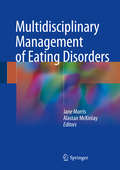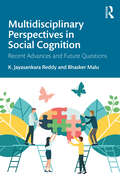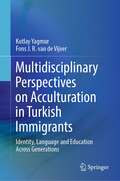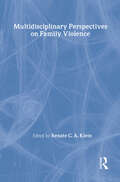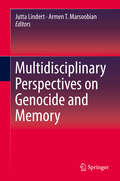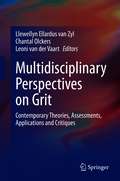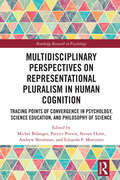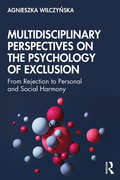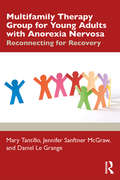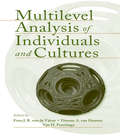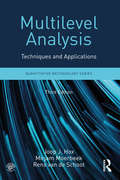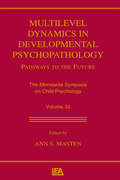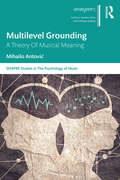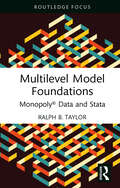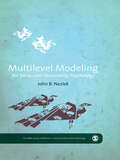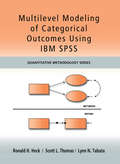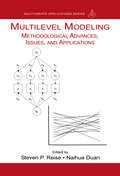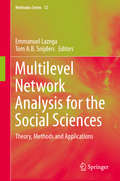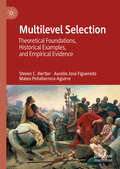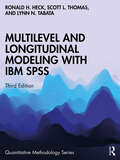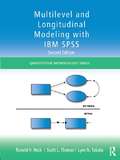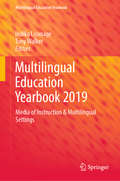- Table View
- List View
Multidisciplinary Management of Eating Disorders
by Jane Morris Alastair McKinlayThis Handbook is an indispensable guide for the multidisciplinary management of eating disorders. It discusses a broad range of issues: managing high-risk patients, the challenges of inserting feeding tubes, addressing nutritional aspects and dealing with additional disorders which might complicate matters, such as diabetes, coeliac disease and cystic fibrosis. It discusses fertility, pregnancy, and eating disorders in children and adolescents, as well as addressing the needs of families. Chapters contain key checklists and flow diagrams. Abundant pictures and conversations, coloured diagrams, charts, maps and boxes, support readers’ varying learning styles and assist retention of key points. Vignettes taken from real (but strenuously anonymised) cases appeal to clinicians’ preference for case-based learning. The book also functions as a practical manual of ‘What to do – and what NOT to do’ with practical scenarios. In the acute situation, clinicians will be able to go directly to the relevant chapter to guide the team through the ‘when, where, how, why and with whom’ of assessing and managing patients with eating disorders. The book is primarily aimed at postgraduate physicians managing patients with Eating disorders on Gastrointestinal, Endocrine or general medical wards, and those who seek to deepen their expertise as they sit higher professional examinations. It is of interest to both medical and psychiatric clinicians, as well as useful to nursing and multidisciplinary staff who want to develop a compassionate understanding of the true pain driving their patients’ behaviours.
Multidisciplinary Perspectives in Social Cognition: Recent Advances and Future Questions
by K. Jayasankara Reddy Bhasker MaluThis book introduces social cognition from multidisciplinary perspectives, exploring in detail how individuals perceive, interpret, and respond to social stimuli throughout different stages of life.The book is organized into five parts, and each chapter provides a concise introduction to a specific topic within social cognition, followed by an in-depth exploration of prominent areas of research, the impact of technology, and potential future questions. The book covers core principles of social cognition alongside application in clinical interventions, with topics including how social cognition evolves throughout the lifespan, the impact of technology and social media on social cognition, and how conditions like autism, schizophrenia, and dementia affect social processing. It links social cognition with critical cognitive domains, including attention, memory, and decision-making, highlighting how these processes interact in shaping social behaviour. The book also combines cross-cultural research with relevant studies to show the differences and similarities in social cognition across geographical distances. Each part concludes with guided questions and answers for students to test their understanding knowledge and learning outcomes. By synthesizing current research and identifying future directions, this book offers valuable insights and potential solutions to the complex challenges in the field of social cognition.Bringing together foundational concepts with advances in the field, the book is ideal reading for students of social psychology, cognitive psychology, social neuroscience, and neuropsychology. It will also be of interest to students and researchers of clinical psychology, providing a foundation for future research in applied settings.
Multidisciplinary Perspectives on Acculturation in Turkish Immigrants: Identity, Language and Education Across Generations
by Fons J. van de Vijver Kutlay YagmurThis book puts forward a new model of acculturation combining psychological, sociolinguistic and identity theories to study Turkish immigrants across the globe. The authors argue that such a multidisciplinary perspective is very important in understanding acculturation processes in migrants, particularly for pivotal aspects such as language and identity. Studying one group or several groups within a country is the most common methodological approach in acculturation studies. The authors argue on the basis of their extensive ethnographic work that focusing on one immigrant ethnic group across countries instead provides deeper insights into interactive acculturation orientations of both the receiving societies and immigrant groups. They therefore synthesize findings from their work on Turkish immigrants in Australia and several countries in Europe. Moreover, they include extensive accounts of acculturation across several generations of Turkish migrants, thereby giving readers insights into the long-term acculturation process. The book critically discusses language maintenance and shift, child-rearing practices and socialization beliefs, and educational achievement in Turkish immigrants, and uses a mixed-methods approach. It is meant for researchers and policy makers interested in acculturation and the role of the acculturation context.In a nutshell, the book stresses the dynamic and ever-evolving nature of linguistic habits and cultural integration tendencies and convinces the reader about the complexity of the background factors that play a role in shaping the behaviour of immigrant minorities. Anyone who reads the book will be equipped with the skills to critically assess research on immigrant language maintenance.
Multidisciplinary Perspectives on Family Violence
by Renate C.A.KleinThis book presents a wide range of issues pertaining to conflict and violence in close, personal relationships. It crosses disciplinary and national boundaries by presenting the work of scholars in psychology, family studies, anthropology, women's studies, sociology and legal philosophy who come from Denmark, France, Germany, Britain, Greece, Poland, Spain and The Netherlands to provide a range of geographical, cultural and historical backgrounds. In association with the International Society for the Study of Personal Relationships.
Multidisciplinary Perspectives on Genocide and Memory
by Jutta Lindert Armen T. MarsoobianThis book explores the memory and representation of genocide as they affect individuals, communities and families, and artistic representations. It brings together a variety of disciplines from public health to philosophy, anthropology to architecture, offering readers interdisciplinary and international insights into one of the most important challenges in the 21st century. The book begins by describing the definitions and concepts of genocide from historical and philosophical perspectives. Next, it reviews memories of genocide in bodies and in societies as well as genocide in memory through lives, mental health and transgenerational effects. The book also examines the ways genocide has affected artistic works. From poetry to film, photography to theatre, it explores a range of artistic approaches to help demonstrate the heterogeneity of representations. This book provides a comprehensive and wide-ranging assessment of the many ways genocide has been remembered and represented. It presents an ideal foundation for understanding genocide and possibly preventing it from occurring again.
Multidisciplinary Perspectives on Grit: Contemporary Theories, Assessments, Applications and Critiques
by Chantal Olckers Leoni van der Vaart Llewellyn Ellardus van ZylThis volume provides a multi-disciplinary perspective on grit, its measurement, manifestation and development. Specifically, it provides a comprehensive and balanced response to critiques associated with the construct within the contemporary positive psychological literature. These critiques revolve around the lack of consensus in the conceptualisation, measurement, and management of grit, as well as consensus on its difference from other psychological constructs such as conscientiousness, diligence or determination. Therefore, this volume thoroughly reappraises and consolidates the nature, function, measurement and implications of grit in order to effectively advance the science of achievement. It looks at grit scales developed in various countries and evaluates the concept in various aspects of life, from work performance to sports. Written by a team of multi-disciplinary experts in fields ranging from neuroscience, sociology, and education to human resource management and psychology, this volume firmly positions grit within the discipline of positive psychology’s nomological lexicon.
Multidisciplinary Perspectives on Representational Pluralism in Human Cognition: Tracing Points of Convergence in Psychology, Science Education, and Philosophy of Science (Routledge Research in Psychology)
by Steven Horst Eduardo F. Mortimer Andrew Shtulman Michel Bélanger Patrice PotvinBringing together diverse theoretical and empirical contributions from the fields of social and cognitive psychology, philosophy and science education, this volume explores representational pluralism as a phenomenon characteristic of human cognition. Building on these disciplines’ shared interest in understanding human thought, perception and conceptual change, the volume illustrates how representational plurality can be conducive to research and practice in varied fields. Particular care is taken to emphasize points of convergence and the value of sharing discourses, models, justifications and theories of pluralism across disciplines. The editors give ample space for philosophers, cognitive scientists and educators to explicate the history and current status of representational pluralism in their own disciplines. Using multiple forms of research from the relational perspective, this volume will be of interest to students, scholars and researchers with an interest in cognitive psychology, as well as educational psychology and philosophy of science.
Multidisciplinary Perspectives on the Psychology of Exclusion: From rejection to personal and social harmony
by Agnieszka WilczyńskaThis new volume considers one of the most pressing topics of the generation: the sense of social exclusion, rejection and loneliness experienced by many adolescents and young adults. It offers insights from psychological and biochemical research, explaining the role of the brain, mind and body in the development of a sense of belonging over the lifespan. Illustrated with examples of the consequences of exclusion drawn from the author’s clinical work, this important work surveys the latest research in the field and introduces an innovative framework for understanding the development of a sense of belonging. Wilczyńska considers the effects of social exclusion, exploring its consequences for mental health, particularly amongst young people, and reveals how transgenerational trauma imprinted at the early stages of human development impacts lifelong development. Including a foreword by Philip Zimbardo, Multidisciplinary Perspectives on the Psychology of Exclusion is essential reading for students and researchers of developmental psychology, social psychology and sociology. It will also be of interest to practitioners and policymakers working with children and young people to understand and mitigate the effects of social exclusion and loneliness.
Multifamily Therapy Group for Young Adults with Anorexia Nervosa: Reconnecting for Recovery
by Daniel Le Grange Mary Tantillo Jennifer L. Sanftner McGrawMultifamily Therapy Group for Young Adults with Anorexia Nervosa describes a new and innovative family-centered outpatient Multifamily Therapy Group (MFTG) approach called Reconnecting for Recovery (R4R) for young adults with anorexia nervosa that is based on a relational reframing of eating disorders. Developed in concert with young adults and their families and informed by clinical observations, theory, and research, R4R is designed to help young adults and family members learn the emotional and relational skills required to avoid or repair relationship ruptures for continued collaboration in recovery. The book begins with an overview of anorexia nervosa, MFTG treatment approaches, and the development of R4R and moves into a session by session review of R4R including session goals, exercises and handouts. Protocols, case vignettes, and other materials help translate the theory and research underlying this multifamily therapy group model into practice. This treatment manual provides readers with explicit guidance in how to develop and conduct an outpatient R4R MFTG and a deeper understanding of the nature, purposes, and processes that characterize one.
Multifunctional And Targeted Theranostic Nanomedicines: Formulation, Design And Applications
by N. K. Jain Keerti JainThis book discusses approaches based on multifunctional and targeted theranostic nanomedicines for improving diagnosis and drug delivery. It explores nanomedicines based on nanocarriers like liposomes, ethosomes, niosomes, polymeric nanoparticles, lipidic nanoparticles, metallic nanoparticles, micelles, dendrimers, quantum dots, carbon-based nanomaterials including carbon nanotubes, carbon dots, carbon quantum dots, graphene oxide, and fullerene. This book reviews designing, conjugation, optimization, formulation and development, and scale-up of multifunctional and targeted theranostic nanomedicines. It examines major challenges in developing nanomaterials that can be applied to nanomedicine with high biocompatibility and biodegradability for diagnostic and therapeutic purposes. Lastly, it addresses the most promising approaches at both commercialization and regulatory steps for bringing theranostic nanomedicine from research laboratories to clinics for patient use.
Multigenerational Family Therapy
by David S FreemanMultigenerational Family Therapy is a book about honoring and helping families. Rich with personal reflections and anecdotes from the author’s many years as a family therapist, this volume’s major strength lies in its precise definition of the process and content of the therapy itself. As the family is the major resource system available to an individual, this important book provides therapists with the keys for helping family members help each other and provides a framework for understanding how the family, as a multigenerational system, moves through various stages of the therapeutic process. By emphasizing the importance of family members utilizing the past as a positive force for change and featuring complete transcripts of family therapy sessions, this sensitive book clearly illustrates how therapists can use the positive forces of family for dealing with today’s uncertainties and dilemmas. The step-by-step approach details how family therapists can work with families in a positive, healing manner. Several chapters illustrate the transition from the beginning to middle phases of family therapy to the terminating phase and provide a framework for how therapy evolves over time. Other chapters discuss the special skills required to work with various family constellations, such as couples, parents with children, siblings, adult children with aged parents, and individuals as well as extended family members. Helpful advice on how to deal with special issues and dilemmas of family therapy such as secret-keeping, affairs, co-therapy, crises and emergencies is also included in this comprehensive book. Beginning and advanced family therapy practitioners, students of family theory and therapy, faculty of social work practice, clinical psychology, nursing, family life education, and counseling psychology will find many positive ideas for working with families in this detailed book.
Multilevel Analysis of Individuals and Cultures
by Ype H. Poortinga Fons J.R. van de Vijver Dianne A. Van HemertIn this book, top specialists address theoretical, methodological, and empirical multilevel models as they relate to the analysis of individual and cultural data. Divided into four parts, the book opens with the basic conceptual and theoretical issues in multilevel research, including the fallacies of such research. Part II describes the methodological aspects of multilevel research, including data-analytic and structural equation modeling techniques. Applications and models from various research areas including control, values, organizational behavior, social beliefs, well-being, personality, response styles, school performance, family, and acculturation, are explored in Part III. This section also deals with validity issues in aggregation models. The book concludes with an overview of the kinds of questions addressed in multilevel models and highlights the theoretical and methodological issues yet to be explored. This book is intended for researchers and advanced students in psychology, sociology, social work, marriage and family therapy, public health, anthropology, education, economics, political science, and cultural and ethnic studies who study the relationship between behavior and culture.
Multilevel Analysis: Techniques and Applications, Second Edition
by Joop J. Hox Rens van de Schoot Mirjam MoerbeekThis practical introduction helps readers apply multilevel techniques to their research. Noted as an accessible introduction, the book also includes advanced extensions, making it useful as both an introduction and as a reference to students, researchers, and methodologists. Basic models and examples are discussed in non-technical terms with an emphasis on understanding the methodological and statistical issues involved in using these models. The estimation and interpretation of multilevel models is demonstrated using realistic examples from various disciplines. For example, readers will find data sets on stress in hospitals, GPA scores, survey responses, street safety, epilepsy, divorce, and sociometric scores, to name a few. The data sets are available on the website in SPSS, HLM, MLwiN, LISREL and/or Mplus files. Readers are introduced to both the multilevel regression model and multilevel structural models. Highlights of the second edition include: Two new chapters--one on multilevel models for ordinal and count data (Ch. 7) and another on multilevel survival analysis (Ch. 8). Thoroughly updated chapters on multilevel structural equation modeling that reflect the enormous technical progress of the last few years. The addition of some simpler examples to help the novice, whilst the more complex examples that combine more than one problem have been retained. A new section on multivariate meta-analysis (Ch. 11). Expanded discussions of covariance structures across time and analyzing longitudinal data where no trend is expected. Expanded chapter on the logistic model for dichotomous data and proportions with new estimation methods. An updated website at http://www.joophox.net/ with data sets for all the text examples and up-to-date screen shots and PowerPoint slides for instructors. Ideal for introductory courses on multilevel modeling and/or ones that introduce this topic in some detail taught in a variety of disciplines including: psychology, education, sociology, the health sciences, and business. The advanced extensions also make this a favorite resource for researchers and methodologists in these disciplines. A basic understanding of ANOVA and multiple regression is assumed. The section on multilevel structural equation models assumes a basic understanding of SEM.
Multilevel Analysis: Techniques and Applications, Third Edition (Quantitative Methodology Series )
by Joop J. Hox Rens van de Schoot Mirjam MoerbeekApplauded for its clarity, this accessible introduction helps readers apply multilevel techniques to their research. The book also includes advanced extensions, making it useful as both an introduction for students and as a reference for researchers. Basic models and examples are discussed in nontechnical terms with an emphasis on understanding the methodological and statistical issues involved in using these models. The estimation and interpretation of multilevel models is demonstrated using realistic examples from various disciplines including psychology, education, public health, and sociology. Readers are introduced to a general framework on multilevel modeling which covers both observed and latent variables in the same model, while most other books focus on observed variables. In addition, Bayesian estimation is introduced and applied using accessible software.
Multilevel Dynamics in Developmental Psychopathology: Pathways to the Future: The Minnesota Symposia on Child Psychology, Volume 34 (Minnesota Symposia On Child Psychology Ser. #Vol. 34)
by Ann S. MastenThis latest volume in The Minnesota Symposia on Child Psychology Series highlights recent research across multiple levels of analysis to understand processes that shape development toward and away from behavioral problems and disorders over the life course, including the pathways to mental health. The book examines how dramatic advances in technolo
Multilevel Grounding: A Theory Of Musical Meaning (SEMPRE Studies in The Psychology of Music)
by Mihailo AntovićMultilevel Grounding develops a new approach to musical meaning—Multilevel-Grounded Semantics, addressing the well- known paradox that music seems full of meaning yet there is little consensus among listeners on what exactly it is that this meaning communicates. Offering a balance between formalist and referentialist approaches, Antovi ć ’s theory proposes that musical signifi cation emerges from constant cross- space mappings between the musical structure and the listener’s experience. The process is crucially constrained by several hierarchical and partly recursive levels of grounding: perceptual, schematically embodied, affective, conceptual, culturally elaborated, and individual. These levels are responsible for a range of phenomena that increase in complexity, from involuntary bodily responses to the manipulation of musical expectancies over cross- modal inferences relating the musical parameters to spatial domains to full- fl edged experiential narratives accompanying the music, as in opera or fi lm scoring. The book combines cutting edge insights from the fi elds of philosophy of mind, cognitive science, semiotics, linguistics, and music cognition, using a broad range of examples from traditional, classical, and popular world musics, into a theoretical system that shows how the focus on the grounding problem may help researchers convincingly resolve the apparent ungraspability of musical semantics.
Multilevel Model Foundations: Monopoly® Data and Stata
by Ralph B. TaylorThis book introduces the foundations of multilevel models, using Monopoly® rent data, from the classic board game, and the statistical program Stata®. Widespread experience with the game means many readers have a head start on understanding these models. The small-data set, 132 rent values for 22 properties clustered by the four sides of the playing board, combines with extensive graphical displays of data and results so all readers can see core multilevel ideas in action at a granular level. Two chapters on standard statistical models, one-way analysis of variance and multiple regression, help readers see how multilevel models rely on but also extend these monolevel ideas. Chapters present three basic multilevel models for cross-sectional analyses – analysis of variance, analysis of covariance, and random coefficients regression – and one basic developmental model for longitudinal analyses. Troubleshooting guidance, combined with close examination of data patterns, and careful inspection of model parameters, all help readers better grasp what model results mean, when model results should or should not be trusted, and how model results link back to core theoretical questions. Consequently, readers will develop a sense of best practices for building and diagnosing their own multilevel models. Those who complete the volume can readily apply what they have learned to more complex datasets and models and adapt available online Stata do files to those projects. Any social scientist working with data clustered in time, in space, or in both, and seeking to learn more about how to use, interpret, or teach these models, will find the book useful.
Multilevel Modeling for Social and Personality Psychology (The SAGE Library of Methods in Social and Personality Psychology)
by John B. NezlekThe volume begins with a rationale for multilevel modeling (MLM). Different aspects of MLM such as centering and modeling error terms are discussed, and examining hypotheses within the multilevel framework is considered in detail. Step by step instructions for conducting multilevel analyses using the program HLM are presented, and these instructions are linked to data sets and program files on a website. The SAGE Library in Social and Personality Psychology Methods provides students and researchers with an understanding of the methods and techniques essential to conducting cutting-edge research. Each volume within the Library explains a specific topic and has been written by an active scholar (or scholars) with expertise in that particular methodological domain. Assuming no prior knowledge of the topic, the volumes are clear and accessible for all readers. In each volume, a topic is introduced, applications are discussed, and readers are led step by step through worked examples. In addition, advice about how to interpret and prepare results for publication are presented.
Multilevel Modeling of Categorical Outcomes Using IBM SPSS: Multilevel Modeling Of Categorical Outcomes Using Ibm Spss (Quantitative Methodology Series)
by Scott Thomas Ronald H Heck Lynn TabataThis is the first workbook that introduces the multilevel approach to modeling with categorical outcomes using IBM SPSS Version 20. Readers learn how to develop, estimate, and interpret multilevel models with categorical outcomes. The authors walk readers through data management, diagnostic tools, model conceptualization, and model specification issues related to single-level and multilevel models with categorical outcomes. Screen shots clearly demonstrate techniques and navigation of the program. Modeling syntax is provided in the appendix. Examples of various types of categorical outcomes demonstrate how to set up each model and interpret the output. Extended examples illustrate the logic of model development, interpretation of output, the context of the research questions, and the steps around which the analyses are structured. Readers can replicate examples in each chapter by using the corresponding data and syntax files available at www.psypress.com/9781848729568. The book opens with a review of multilevel with categorical outcomes, followed by a chapter on IBM SPSS data management techniques to facilitate working with multilevel and longitudinal data sets. Chapters 3 and 4 detail the basics of the single-level and multilevel generalized linear model for various types of categorical outcomes. These chapters review underlying concepts to assist with trouble-shooting common programming and modeling problems. Next population-average and unit-specific longitudinal models for investigating individual or organizational developmental processes are developed. Chapter 6 focuses on single- and multilevel models using multinomial and ordinal data followed by a chapter on models for count data. The book concludes with additional trouble shooting techniques and tips for expanding on the modeling techniques introduced. Ideal as a supplement for graduate level courses and/or professional workshops on multilevel, longitudinal, latent variable modeling, multivariate statistics, and/or advanced quantitative techniques taught in psychology, business, education, health, and sociology, this practical workbook also appeals to researchers in these fields. An excellent follow up to the authors’ highly successful Multilevel and Longitudinal Modeling with IBM SPSS and Introduction to Multilevel Modeling Techniques, 2nd Edition, this book can also be used with any multilevel and/or longitudinal book or as a stand-alone text introducing multilevel modeling with categorical outcomes.
Multilevel Modeling: Methodological Advances, Issues, and Applications (Multivariate Applications Series)
by Steven P. Reise Naihua DuanThis book illustrates the current work of leading multilevel modeling (MLM) researchers from around the world. The book's goal is to critically examine the real problems that occur when trying to use MLMs in applied research, such as power, experimental design, and model violations. This presentation of cutting-edge work and statistical innovations in multilevel modeling includes topics such as growth modeling, repeated measures analysis, nonlinear modeling, outlier detection, and meta analysis. This volume will be beneficial for researchers with advanced statistical training and extensive experience in applying multilevel models, especially in the areas of education; clinical intervention; social, developmental and health psychology, and other behavioral sciences; or as a supplement for an introductory graduate-level course.
Multilevel Network Analysis for the Social Sciences
by Emmanuel Lazega Tom A.B. SnijdersThis volume provides new insights into the functioning of organizational, managerial and market societies. Multilevel analysis and social network analysis are described and the authors show how they can be combined in developing the theory, methods and empirical applications of the social sciences. This book maps out the development of multilevel reasoning and shows how it can explain behavior, through two different ways of contextualizing it. First, by identifying levels of influence on behavior and different aggregations of actors and behavior, and complex interactions between context and behavior. Second, by identifying different levels as truly different systems of agency: such levels of agency can be examined separately and jointly since the link between them is affiliation of members of one level to collective actors at the superior level. It is by combining these approaches that this work offers new insights. New case studies and datasets that explore new avenues of theorizing and new applications of methodology are presented. This book will be useful as a reference work for all social scientists, economists and historians who use network analyses and multilevel statistical analyses. Philosophers interested in the philosophy of science or epistemology will also find this book valuable.
Multilevel Selection: Theoretical Foundations, Historical Examples, and Empirical Evidence
by Steven C. Hertler Aurelio José Figueredo Mateo Peñaherrera-AguirreThis book embeds a novel evolutionary analysis of human group selection within a comprehensive overview of multilevel selection theory, a theory wherein evolution proceeds at the level of individual organisms and collectives, such as human families, tribes, states, and empires. Where previous works on the topic have variously supported multilevel selection with logic, theory, experimental data, or via review of the zoological literature; in this book the authors uniquely establish the validity of human group selection as a historical evolutionary process within a multilevel selection framework.Select portions of the historical record are examined from a multilevel selectionist perspective, such that clashing civilizations, decline and fall, law, custom, war, genocide, ostracism, banishment, and the like are viewed with the end of understanding their implications for internal cohesion, external defense, and population demography. In doing so, its authors advance the potential for further interdisciplinary study in fostering, for instance, the convergence of history and biology. This work will provide fresh insights not only for evolutionists but also for researchers working across the social sciences and humanities.
Multilevel and Longitudinal Modeling with IBM SPSS (Quantitative Methodology Series)
by Ronald H. Heck Scott L. Thomas Lynn N. TabataMultilevel and Longitudinal Modeling with IBM SPSS, Third Edition, demonstrates how to use the multilevel and longitudinal modeling techniques available in IBM SPSS Versions 25-27. Annotated screenshots with all relevant output provide readers with a step-by-step understanding of each technique as they are shown how to navigate the program. Throughout, diagnostic tools, data management issues, and related graphics are introduced. SPSS commands show the flow of the menu structure and how to facilitate model building, while annotated syntax is also available for those who prefer this approach. Extended examples illustrating the logic of model development and evaluation are included throughout the book, demonstrating the context and rationale of the research questions and the steps around which the analyses are structured. The book opens with the conceptual and methodological issues associated with multilevel and longitudinal modeling, followed by a discussion of SPSS data management techniques that facilitate working with multilevel, longitudinal, or cross-classified data sets. The next few chapters introduce the basics of multilevel modeling, developing a multilevel model, extensions of the basic two-level model (e.g., three-level models, models for binary and ordinal outcomes), and troubleshooting techniques for everyday-use programming and modeling problems along with potential solutions. Models for investigating individual and organizational change are next developed, followed by models with multivariate outcomes and, finally, models with cross-classified and multiple membership data structures. The book concludes with thoughts about ways to expand on the various multilevel and longitudinal modeling techniques introduced and issues (e.g., missing data, sample weights) to keep in mind in conducting multilevel analyses. Key features of the third edition: Thoroughly updated throughout to reflect IBM SPSS Versions 26-27. Introduction to fixed-effects regression for examining change over time where random-effects modeling may not be an optimal choice. Additional treatment of key topics specifically aligned with multilevel modeling (e.g., models with binary and ordinal outcomes). Expanded coverage of models with cross-classified and multiple membership data structures. Added discussion on model checking for improvement (e.g., examining residuals, locating outliers). Further discussion of alternatives for dealing with missing data and the use of sample weights within multilevel data structures. Supported by online data sets, the book's practical approach makes it an essential text for graduate-level courses on multilevel, longitudinal, latent variable modeling, multivariate statistics, or advanced quantitative techniques taught in departments of business, education, health, psychology, and sociology. The book will also prove appealing to researchers in these fields. The book is designed to provide an excellent supplement to Heck and Thomas's An Introduction to Multilevel Modeling Techniques, Fourth Edition; however, it can also be used with any multilevel or longitudinal modeling book or as a stand-alone text.
Multilevel and Longitudinal Modeling with IBM SPSS: Multilevel And Longitudinal Modeling With Ibm Spss (Quantitative Methodology Series)
by Ronald H. Heck Scott L. Thomas Lynn N. TabataThis book demonstrates how to use multilevel and longitudinal modeling techniques available in the IBM SPSS mixed-effects program (MIXED). Annotated screen shots provide readers with a step-by-step understanding of each technique and navigating the program. Readers learn how to set up, run, and interpret a variety of models. Diagnostic tools, data management issues, and related graphics are introduced throughout. Annotated syntax is also available for those who prefer this approach. Extended examples illustrate the logic of model development to show readers the rationale of the research questions and the steps around which the analyses are structured. The data used in the text and syntax examples are available at www.routledge.com/9780415817110. Highlights of the new edition include: Updated throughout to reflect IBM SPSS Version 21. Further coverage of growth trajectories, coding time-related variables, covariance structures, individual change and longitudinal experimental designs (Ch.5). Extended discussion of other types of research designs for examining change (e.g., regression discontinuity, quasi-experimental) over time (Ch.6). New examples specifying multiple latent constructs and parallel growth processes (Ch. 7). Discussion of alternatives for dealing with missing data and the use of sample weights within multilevel data structures (Ch.1). The book opens with the conceptual and methodological issues associated with multilevel and longitudinal modeling, followed by a discussion of SPSS data management techniques which facilitate working with multilevel, longitudinal, and cross-classified data sets. Chapters 3 and 4 introduce the basics of multilevel modeling: developing a multilevel model, interpreting output, and trouble-shooting common programming and modeling problems. Models for investigating individual and organizational change are presented in chapters 5 and 6, followed by models with multivariate outcomes in chapter 7. Chapter 8 provides an illustration of multilevel models with cross-classified data structures. The book concludes with ways to expand on the various multilevel and longitudinal modeling techniques and issues when conducting multilevel analyses. Ideal as a supplementary text for graduate courses on multilevel and longitudinal modeling, multivariate statistics, and research design taught in education, psychology, business, and sociology, this book’s practical approach also appeals to researchers in these fields. The book provides an excellent supplement to Heck & Thomas’s An Introduction to Multilevel Modeling Techniques, 2nd Edition; however, it can also be used with any multilevel and/or longitudinal modeling book or as a stand-alone text.
Multilingual Education Yearbook 2019: Media of Instruction & Multilingual Settings (Multilingual Education Yearbook)
by Indika Liyanage Tony WalkerThis book offers essential insights into the challenges and complexities surrounding the medium of instruction (MOI), its impact on all languages and stakeholders in multilingual contexts, educational processes, developments and outcomes. MOI has been a prominent topic in recent debates on the role of languages in education in multilingual contexts, partly because prioritizing one language over others as the medium of instruction has a profound impact on all languages and stakeholders in multilingual contexts. These include, to name but a few, (language) teachers, teacher educators, students, and policymakers, as well as industries and enterprises built around the needs and expectations of these stakeholders. This book presents high-quality empirical research on education in multilingual societies. It highlights research findings that, in addition to providing descriptions of language learning, development and use in language contact and multilingual contexts, will help shape future language education policy and practices in multilingual societies.
